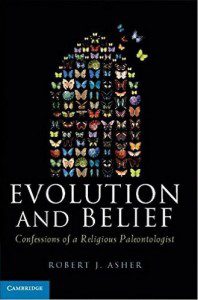 What does it mean to think scientifically?
What does it mean to think scientifically?
Uniformitarianism and Naturalism. In the second chapter of Evolution and Belief Robert Asher, Curator of Vertebrates in the Museum of Zoology at the University of Cambridge, outlines his thoughts on what it means to think scientifically and contrasts this with some of the ways Christians approach the question of the origin of the diversity of life.
First, historical science and naturalism. Uniformitarianism is a key, and a core target of the objections of those who hold to a young earth. What is uniformitarianism?
Even though a phenomenon may have occurred long ago, it is still possible to make scientific inferences because we can be confident that the phenomenon of erosion, gravity, decay, etc. that we observe today would have also been applicable at that time. This draws upon the principle of uniformitariansim, a term made famous by one of Darwin’s mentors, British geologist Sir Charles Lyell. … In terms of its focus on the past, evolutionary biology is not substantially different as a scientific discipline than astronomy, forensics, or geology. We take the evidence we have, even if removed temporally from our present perspective, and make rational predictions of discoveries that should follow if our proposition is true, assuming that the physics, mathematics, and chemistry that we know today are also relevant to the past.
Uniformitarianism is a kind of naturalism … As understood today, it is not quite the same as the “laws” advanced by Lyell in the early nineteenth century, which included now-outdated ideas about an overly monotonic pace of geologic change. Nevertheless, the essence of uniformitarianism, i.e., the notion that processes observable today are applicable to the past, represents the core of the scientific method. … Naturalism is a pragmatic methodology that underpins scientific efforts to figure out how things work. Without naturalism, we’d have to admit that maybe water has previously run uphill, since people have not always been around to testify one way or the other. (p. 29-30)
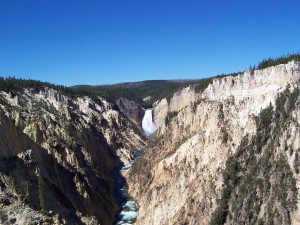 Under the hypothesis of uniformitarianism the rate of change can vary dramatically as long as the underlying chemistry and physics remains valid. A canyon can form slowly – such as the Grand Canyon, which was formed by erosion over the course of many millions of years – a process underway yet today. In contrast, the Grand Canyon of the Yellowstone (right) was formed by the catastrophic release of an ice dam (probably more than once) at the end of the last ice age some 14000 to 18000 years ago with the massive floods causing immediate formation of the canyon. Slower erosion by the Yellowstone river continues to deepen the canyon today. Both processes are consistent with uniformitarianism. The laws of physics we know today controlled the processes. In biology gradual change, punctuated equilibrium, and “rapid” speciation under selective stress are all with uniformitarianism.
Under the hypothesis of uniformitarianism the rate of change can vary dramatically as long as the underlying chemistry and physics remains valid. A canyon can form slowly – such as the Grand Canyon, which was formed by erosion over the course of many millions of years – a process underway yet today. In contrast, the Grand Canyon of the Yellowstone (right) was formed by the catastrophic release of an ice dam (probably more than once) at the end of the last ice age some 14000 to 18000 years ago with the massive floods causing immediate formation of the canyon. Slower erosion by the Yellowstone river continues to deepen the canyon today. Both processes are consistent with uniformitarianism. The laws of physics we know today controlled the processes. In biology gradual change, punctuated equilibrium, and “rapid” speciation under selective stress are all with uniformitarianism.
Concerning the Grand Canyon, Asher continues:
We can be sure that throughout Earth’s history, gravity has had some effect on the action of water because we see the results in both modern and ancient geological deposits. Gravity holds a small vertebrate to the ground as it runs across a muddy surface, leaving tracks. A flood inundating that surface – again driven by the action of gravity – would erase those tracks and leave behind particles of varying sizes, proportional to the energy of the flood (more energy transports larger particles). Low-energy deposition, for example at the bottom of a lake, would yield a deposit with relatively fine-grained, homogeneous particles. Vertebrate tracks and fine-grained deposits are exactly what we see scattered throughout the various layers in the rock exposures of the Grand Canyon of northern Arizona. … These things result from gradual deposition of sediment over a long period of time; they do not negate the observation that other phenomena evident within the several thousand feet of Grand Canyon geological section can occur quite suddenly, such as an intrusive flow of volcanic rock. The explanation of the patterns observed in the rocks of the Grand Canyon is a simple extrapolation from the processes that we know would form them today, requiring, among other things, that water run downhill. (p. 30)
There is another misconception that can be cleared up as well. Uniformitarianism does not mean that the conditions present today were always present.
For example, we know that days now are slightly longer than they were during the Paleozoic; that the oxygen content of the Earth’s atmosphere has varied tremendously over time; that the positions of the continents, with major consequences for ocean currents and climate, were quite different in previous geological eras. Naturalism does not mean that everything we observe today must have always been so. Rather it enables scientists to make inferences about remote events based on the physical processes that are accessible to us today. (p. 30)
Noah’s Flood. Later in the chapter, in a section on science and hypothesis testing Asher brings up the example of the Flood and Noah’s ark. According to Genesis the ark was 300×30×50 cubits – or about the size of “a mid-sized cargo ship.” This is not small, but not enormous either. It is too small to hold a mating pair of each species of land animal and an additional five of every clean animal (not to mention the birds that would have needed a roost during the flood, seven of each of these as well – Gen 7:3), along with food to sustain the population. If we reason from the current state of affairs the verdict concerning the ark must be negative. Unless something special happened (in addition to the inundating waters) … such as all animals placed in a coma or miniaturized, it doesn’t compute. “By appealing to some unknowable, supernatural circumstance … you wouldn’t qualify as a scientist,… You might be correct, but you would not be behaving scientifically. (p. 38)”
By rational standards, the biomass of the requisite animal life and the technology required to sustain creatures from temperate, tropical, montane, desert, subterranean, arctic, and aquatic environments for several months on a ship comprise data that clearly falsify the hypothesis of the ark, not to mention beg the question as to how these organisms attained their current distributions. (And what about all those plants and fresh-water fish, and invertebrates?) You can still opt to believe in Genesis as a literal exposition of Earth history, but in doing so you are not abiding by common sense in either its vanilla or scientific flavors. A literal belief in this particular bit of scripture is irrational based on the principles of nature and common sense. (p. 38)
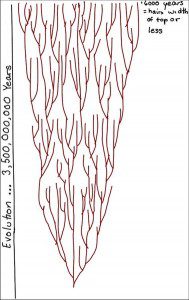 Of course, this observation isn’t unique to Asher and hasn’t escaped the notice of those defending a young earth and a global flood. A recent post on Naturalis Historia “Ken Ham’s Rapid Post-Flood Diversification Really Evolution? A Rose by any Other Name…” digs into some of the ways that the problem of the flood is dealt with by young earth creationists. One strategy is to limit the occupants of the ark to “kinds” with a dog-like representative, a deer-like representative, a cat-like representative, an elephant-like representative, and so forth. In this case the biomass on the ark can be reduced to a manageable level. For example, the article “No Kind Left Behind” at Answers in Genesis runs through some of the reasoning that is used. This resolution brings its own baggage however. It doesn’t resolve the distribution problem and it requires rapid “evolution” to move from, say 1500 kinds, (some now extinct) to the vast diversity and distribution of animal life we observe today. This requires very fast development of new species from the representative kinds on the ark.
Of course, this observation isn’t unique to Asher and hasn’t escaped the notice of those defending a young earth and a global flood. A recent post on Naturalis Historia “Ken Ham’s Rapid Post-Flood Diversification Really Evolution? A Rose by any Other Name…” digs into some of the ways that the problem of the flood is dealt with by young earth creationists. One strategy is to limit the occupants of the ark to “kinds” with a dog-like representative, a deer-like representative, a cat-like representative, an elephant-like representative, and so forth. In this case the biomass on the ark can be reduced to a manageable level. For example, the article “No Kind Left Behind” at Answers in Genesis runs through some of the reasoning that is used. This resolution brings its own baggage however. It doesn’t resolve the distribution problem and it requires rapid “evolution” to move from, say 1500 kinds, (some now extinct) to the vast diversity and distribution of animal life we observe today. This requires very fast development of new species from the representative kinds on the ark.
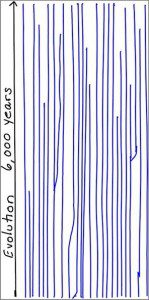 In mainstream evolutionary biology it is generally accepted that the evolution of the diversity of life from the earliest common ancestors has been an ongoing process for the last 3.5 billion years. (We are not considering the origin of life, only the origin of the diversity of life.) Six thousand years is an almost insignificant segment of this whole process. Over the last six thousand years the process resembles the second figure here, not the first above (these figures adapted from an illustration in the Naturalis Historia post linked above). Human experience has witnessed extinctions, but evolution of new species is a slow process requiring many generations. Experiments can probe relatively small changes in bacteria, but not larger scale changes in long-lived mammals. In fact, I have probably over-estimated the occurrence of new species as a percentage of the total in this illustration.
In mainstream evolutionary biology it is generally accepted that the evolution of the diversity of life from the earliest common ancestors has been an ongoing process for the last 3.5 billion years. (We are not considering the origin of life, only the origin of the diversity of life.) Six thousand years is an almost insignificant segment of this whole process. Over the last six thousand years the process resembles the second figure here, not the first above (these figures adapted from an illustration in the Naturalis Historia post linked above). Human experience has witnessed extinctions, but evolution of new species is a slow process requiring many generations. Experiments can probe relatively small changes in bacteria, but not larger scale changes in long-lived mammals. In fact, I have probably over-estimated the occurrence of new species as a percentage of the total in this illustration.
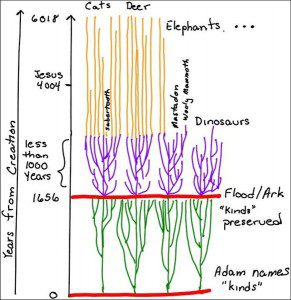 In contrast, the young earth view is anything but static. In order to account for the fossil record and the diversity and distribution of life on earth for the last 6000 years, a young earth view contains several distinct eras. God initially created kinds, few enough that Adam could name them on day 6. These diversified and filled the earth. The flood produced a second bottle neck with the distribution again limited to a small number of kinds. Immediately after the flood the diversification process resumed at an accelerated rate. The image to the right doesn’t really do justice to the process and other variants are possible (for example one could propose that the saber-tooth tiger, mammoth and mastodon could have gone extinct at the flood). But the important point is that the rapid diversification from creation to the flood and again after the flood is change occurring far faster than any “natural” process (i.e. the laws of physics and chemistry) can justify. As Robert Asher noted, it may be right, but it is not scientific.
In contrast, the young earth view is anything but static. In order to account for the fossil record and the diversity and distribution of life on earth for the last 6000 years, a young earth view contains several distinct eras. God initially created kinds, few enough that Adam could name them on day 6. These diversified and filled the earth. The flood produced a second bottle neck with the distribution again limited to a small number of kinds. Immediately after the flood the diversification process resumed at an accelerated rate. The image to the right doesn’t really do justice to the process and other variants are possible (for example one could propose that the saber-tooth tiger, mammoth and mastodon could have gone extinct at the flood). But the important point is that the rapid diversification from creation to the flood and again after the flood is change occurring far faster than any “natural” process (i.e. the laws of physics and chemistry) can justify. As Robert Asher noted, it may be right, but it is not scientific.
There are many problems with the scenario in the last figure, with the lack of a scientific explanation for rapid speciation only one. More importantly, there is no record, in scripture or elsewhere, of people noticing these rapid changes in animal life. Instead recorded history notes that animals produce young like themselves. Evolution is not observed on the scale of human lifetimes.
Joel Duff at Naturalis Historia has a number of good posts on the post-flood conundrum in addition to the one I’ve linked above. If interested, I recommend these – and a careful reading of the articles defending a young earth at AiG as well. Scientific thinking is critical thinking, testing hypotheses and searching for mechanisms.
When and how should Christians think scientifically?
Do you see any problems with Asher’s definitions?
Is uniformitarianism as defined by Asher a reasonable hypothesis?
If you wish to contact me directly you may do so at rjs4mail[at]att.net.
If interested you can subscribe to a full text feed of my posts at Musings on Science and Theology.















